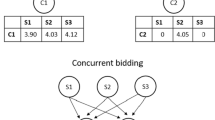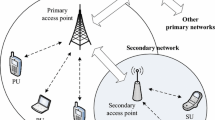Abstract
Cognitive radio is an emerging technique to improve the utilization of radio frequency spectrum in wireless communication networks. That is, spectrum efficiency can be increased significantly by giving opportunistic access of the frequency bands to a group of cognitive users to whom the band has not been licensed. In this paper, as a cross layer application (MAC and physical layers) of graph theory, we consider the problem of throughput maximization of spectrum allocation in cognitive radio networks under interference constraint. We propose a novel auction-based channel allocation mechanism which tries to maximize both total and primary users’ utilities while satisfying signal to interference ratio constraint on primary receivers so that transmitted packets will be successfully received, without controlling secondary user powers. For comparison we discuss a greedy algorithm as well, however, one that does not handle interference issue. In order to compare results of proposed and greedy algorithms, we propose net throughput by taking into account outage probability of primary receiver. Simulation results show that exposing higher SINR (outage) threshold not only decreases total gain and primary users’ utilities but also worsens channel distribution performance. On the other hand adding auction mechanism significantly increases total gain throughput and primary user’ s utility. Particularly, up to SINR threshold values of 20 dBs, auction provides outstanding performance and proposed algorithm has total throughput results close to those of the greedy one even though no interference constraint is applied in the greedy algorithm. Another noticeable point of simulation results is crossover of net throughputs of proposed and greedy algorithms at a SINR threshold level after which results of ABSA-UNIC and NASA-UNIC are much better. This clearly shows superiority of proposed mechanism.









Similar content being viewed by others
References
Ileri, O., Samardzija, D., & Mandayam, N. B. (2005). Demand responsive pricing and competitive spectrum allocation via a spectrum server. IEEE International Symposium on New Frontiers in Dynamic Spectrum Access Networks–DySPAN, 194–202.
Akyildiz, I. F., Lee, W., Vuran, M. C., & Mohanty, S. (2006). Next generation/dynamic spectrum access/cognitive radio wireless networks: A survey. Computer Networks, 50(13), 2127–2159.
Buddhikot, M. M. (2005). Dimsumnet: New directions in wireless networking using coordinated dynamic spectrum. IEEE International Symposium on a World of Wireless Mobile and Multimedia Networks, 78–85.
Etkin, R., Parekh, A., & Tse, D. (2005). Spectrum sharing for unlicensed bands. IEEE Journal on Selected Areas in Communications, 25(3), 517–528.
Peng, C., Zheng, H., & Zhao, B. (2006). Utilization and fairness in spectrum assignment for opportunistic spectrum Access. ACM Mobile Networks and Applications, 11, 555–576
Xin, C. S., Xie, B., & Shen, C. C. (2005) A novel layered graph model for topology formation and routing in dynamic spectrum access networks. IEEE International Symposium on New Frontiers in Dynamic Spectrum Access Networks, 308–317.
Xuezhi, T., Yutao, L., & Guisen, X. (2009). Dynamic Spectrum allocation in cognitive radio: Auction and equilibrium. International Forum on Information Technology and Applications, 1, 554–558.
Huang, J., Berry, R., & Honig, M. L. (2006). Auction-based spectrum sharing. Mobile Networks and Applications, 11(3), 405–408.
Digham, F. F. (2008). Joint power and channel allocation for cognitive radios. IEEE Wireless Communications and Networking Conference Proceedings, 882–887.
Ghasemi, A., & Sousa, E. S. (2008). Interference aggregation in spectrum-sensing cognitive wireless networks. IEEE Journal Of Selected Topics in Signal Processing, 2(1), 41–56.
Vu, M., Ghassemzadeh, S. S., & Tarokh, V. (2008). Interference in a cognitive network with beacon. IEEE Wireless Communications and Networking Conference, 876–881.
Mark, B. L., & Nasif, A. O. (2009). Estimation of Maximum interference-free power level for opportunistic spectrum access. IEEE Transactions On Wireless Communications, 8(5), 2505–2513.
Ma, M., & Tsang, D. H. K. (2010). Cross-layer throughput optimization in cognitive radio networks with SINR constraints. International Journal of Digital Multimedia Broadcasting, Article ID 985458.
Liu, Y., Xu, G., & Tan, X. (2009). A novel spectrum allocation mechanism based on graph coloring and bidding theory. International Conference on Computational Intelligence and Natural Computing, 1, 155–158.
Author information
Authors and Affiliations
Corresponding author
Rights and permissions
About this article
Cite this article
Karaca, H.M., Kurt, T., Zafer Dicle, S. et al. Auction-Based Throughput Maximization in Cognitive Radio Networks Under Interference Constraint. Wireless Pers Commun 72, 1259–1275 (2013). https://doi.org/10.1007/s11277-013-1076-1
Published:
Issue Date:
DOI: https://doi.org/10.1007/s11277-013-1076-1




